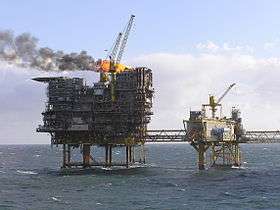Tyra Field
Tyra Field is the largest gas condensate field in the Danish Sector of the North Sea.[1] It was discovered in 1968 and production started in 1984.[2] The field is owned by Dansk Undergrunds Consortium, a partnership between Total, Noreco and Nordsofonden, and operated by Total.[3] The reservoir depth is about 2,000 metres (6,600 ft) and it covers area of 90 kilometres (56 mi) in the water depth of 37–40 metres (121–131 ft).[2]
| Tyra Field | |
|---|---|
 Platform at Tyra East | |
| Country | Denmark |
| Region | North Sea |
| Block | 5504/11 5504/12 |
| Offshore/onshore | offshore |
| Operator | Total |
| Partners | Total Noreco Nordsofonden |
| Field history | |
| Discovery | 1968 |
| Start of production | 1984 |
| Production | |
| Current production of gas | 237.8×106 cu ft/d (6.73×106 m3/d) |
| Estimated gas in place | 1,250×109 cu ft (35×109 m3) |
| Producing formations | Danian and Upper Cretaceous Chalk |
History
In August 2017 Maersk Oil was sold to Total S.A. with the takeover completed in 2018.
Redevelopment
On 1 December 2017 Maersk Oil announced a 21 billion dkk investment in the redevelopment of Tyra Field.[4] The living and processing platform on Tyra East and Tyra West will be scrapped. One new living platform and one new processing platform will be built. The living quarter platform will be constructed by Italian EPC contractor Rosetti Marino, while processing platform will be constructed in Kuala Lumpur by American EPC contractor McDermott International. During the refit the production will be closed from November 2019 to July 2022.[4] In July 2018 Modern American Recycling Services based in Frederikshavn secured a contract to scrap the two platforms.[5]
Facilities
The Tyra Field has two production complexes named Tyra West and Tyra East, connected by pipelines. Tyra West includes oil and gas processing plants which in addition to the gas produced at the Tyra field, processes also gas from Halfdan and Valdemar fields. The complex consists of two wellhead platforms, one processing and accommodation platform, and one gas flare stack. Tyra East processes also oil and gas from Valdemar, Roar, Svend, Tyra Southeast, Harald, Lulita, Gorm and Dan fields. It consists of two wellhead platforms, one processing and accommodation platform, one gas flare stack, and one riser platform.[2]
In total, the field has 20 gas-producing wells, and 28 oil and gas-producing wells.[2]
Produced oil is transported to the Gorm E riser platform in the Gorm field, and further through the subsea pipeline to the oil terminal in Fredericia, Denmark. Produced natural gas is transported from the Tyra East riser platform to Nybro Gas Processing Plant, Denmark, and from Tyra West riser platform to the Netherlands through the Tyra West – F3 and NOGAT pipelines.[6]
References
- Glennie, K. W. (1998). Petroleum geology of the North Sea: basic concepts and recent advances. Wiley-Blackwell. p. 343. ISBN 978-0-632-03845-9.
- "Oil and Gas Production in Denmark 07. Appendix B: Producing Fields". Danish Energy Agency. Archived from the original on 2012-11-30. Retrieved 2011-01-15.
- https://www.ep.total.com/en/tyra-gas-field-starts-its-redevelopment
- Wittrup, Sanne (1 December 2017). "Største Nordsø-investering nogensinde: Tyrafelt ombygges for 21 mia. kroner". Ingeniøren (in Danish). Retrieved 22 January 2019.
- "Merry Christmas and Happy New Year". Port of Frederikshavn. 2018-12-19. Retrieved 2019-01-22.
- International Energy Agency (2006). Energy policies of IEA countries: Denmark 2006 review (PDF). OECD. p. 146. ISBN 978-92-64-10971-1.